The hidden narrative behind ZEC's surge: The migration of a safe haven for "Chen Zhi and Qian Zhimin"
Bitcoin serves as insurance against fiat currency; Zcash (ZEC) is insurance against Bitcoin.
The U.S. government shutdown has finally ended under much public attention, but market sentiment has not warmed up as a result.
The crypto market not only failed to see the expected “rebound after bad news is fully priced in,” but instead continued to be dominated by a bearish sentiment: BTC once lost the $90,000 mark, ETH once fell below $2,900, and the “fall of all coins” has almost become the footnote of the current market. Only the privacy sector, represented by ZEC, has bucked the trend and shown a remarkably independent performance.
Meanwhile, two major cases that have shaken the industry are fermenting simultaneously: the 127,000 BTC held by “Prince Group” leader Chen Zhi was confiscated by the U.S. government; the mastermind behind “Lantian Gerui,” Qian Zhimin, who was involved in illegal fundraising of over 40 billion yuan, was arrested after seven years on the run, and the fate of over 60,000 BTC assets under her name remains unresolved.
Behind these two events, a domino effect has been triggered—the censorship resistance and anonymity of Bitcoin are being questioned as never before by tech geeks, fundamentalists, and even mysterious gray-market whales.
When the authoritarian power of the real world collides head-on with the ideals of decentralized technology, the result is far from romantic, causing idealists to reflect:From the ultimate ownership of BTC assets, it is the state apparatus that is the final winner.
This also forces the crypto industry to face an old question again:If BTC can hardly fulfill the role of “censorship-resistant currency,” then who will be the next symbol of privacy rights and on-chain asset storage?The market may have already given its answer—at this point in time, ZEC, which is bucking the trend and rising, is becoming the right “version of the answer.”
The strong surge in ZEC may not be a manipulation by market makers, but rather a result of real long-term market demand from whales. This conclusion is supported by multiple narratives and data dimensions.
When the heavy hand of authoritarian governments shatters the illusion of “censorship-resistant currency”: BTC is no longer a noble “safe haven” asset
One of the direct reasons for the renewed faith in ZEC as a “privacy token” is the hidden information revealed by the recent two major “BTC mega-asset cases”:The censorship resistance and anonymity of BTC are facing severe tests.
First, let’s talk about the case of Chen Zhi, the “Prince Group” leader, involving $15 billion in funds.
Previously, Odaily provided a detailed introduction to the case in the article “$15 Billion BTC Changes Hands: U.S. Department of Justice Wipes Out Cambodia’s Prince Group, Becomes the World’s Largest BTC Whale,” which mentioned the specific “BTC confiscation process”—
(In this case) judicial and intelligence agencies demonstrated a complete set of procedures for handling on-chain assets: on-chain tracking → financial blockade → judicial takeover. This is a real-world closed loop that seamlessly connects “on-chain tracking capabilities” with “traditional judicial power”:
Step one: On-chain tracking—locking the “fund container.” Bitcoin’s anonymity is often misunderstood. In fact, its blockchain is a public ledger, and every transaction leaves a trace. The Chen Zhi Group tried to launder money using the classic “spray-funnel” model: dispersing funds from the main wallet like watering with a can to a large number of intermediate addresses, then, after a short stay, aggregating them back to a few core addresses like streams merging into a river. This operation seems complex, but from an on-chain analysis perspective, frequent “dispersal-aggregation” behaviors actually form unique graph patterns. Investigative agencies (such as TRM Labs, Chainalysis) use clustering algorithms to accurately map the “funds return map,” ultimately confirming that these seemingly dispersed addresses all point to the same controlling entity—the Prince Group.
Step two: Financial sanctions—cutting off the “cash-out channel.” After locking the on-chain assets, U.S. authorities initiated dual financial sanctions: Treasury Department (OFAC) sanctions: listing Chen Zhi and related entities, prohibiting any U.S.-jurisdiction institution from transacting with them. Financial Crimes Enforcement Network (FinCEN) §311: designating key entities as “primary money laundering concerns,” completely cutting off their access to the U.S. dollar clearing system. At this point, although these bitcoins can still be controlled by private keys on-chain, their most important value attribute—“the ability to be exchanged for U.S. dollars”—has been frozen.
Step three: Judicial takeover—completing the “ownership transfer.” The final confiscation did not rely on brute-force cracking of private keys, but rather law enforcement agencies directly took over the “signing rights” of the assets through legal procedures (such as court orders). This means law enforcement successfully obtained mnemonic phrases, private keys, or controlled hardware wallets, enabling them to initiate valid transfer transactions like the original asset owner, moving the bitcoins to government-controlled addresses. However, in the Chen Zhi case, the specific method by which the U.S. government obtained the private keys has not been fully disclosed; thus, the community speculates, based on previous Lubian.com security vulnerabilities, that law enforcement may have exploited such vulnerabilities to crack the private keys. The moment this transaction is confirmed by the blockchain network, “legal ownership” and “on-chain control” are unified.
The ownership of these 127,271 BTC, in both technical and legal terms, has officially transferred from Chen Zhi to the U.S. government. This combination clearly demonstrates: in the face of state power, “on-chain assets are inalienable” is not absolute.

$15 Billion BTC Asset Transfer Process
This matter was subsequently explained in detail in the “Technical Traceability Analysis Report on the LuBian Mining Pool Hacked and Stolen Massive Bitcoin Incident” released by the National Computer Virus Emergency Response Center, stating that this “largest virtual asset confiscation in history” was actually a “classic state-level hacker group orchestrated ‘black eats black’ event.” In the crypto world, which is like a dark forest, not only are there “national teams” like Lazarus Group from North Korea, but the “U.S. team” as “on-chain special forces” is also quietly lurking in the shadows.
Compared to Chen Zhi, who advanced step by step in Southeast Asia, the story of Qian Zhimin, the protagonist of the 60,000 BTC money laundering case, is even more legendary and tortuous.
According to Caixin, she first learned about Bitcoin in 2012, “her ambition was to one day own 210,000 bitcoins, accounting for 1% of the total supply.” She almost achieved this goal: from June 2014 to June 2017, over three years, Qian Zhimin instructed her “front figures” to buy a total of 194,951 BTC, with an average purchase price of only 2,815 yuan per coin (statistical basis unknown). By the time she was sentenced in the UK in November this year, the price of Bitcoin had soared 266 times to 750,000 yuan per coin.
Qian Zhimin’s diary, written between May and July 2018, shows that she made a “six-year plan” for 2018 to 2023, with the core goal of “retiring at 45” and “rebuilding a digital empire.” She required herself to “maintain at least three identities,” including St. Kitts and Nevis and “two European countries (at least one unknown to others but allowing free travel in Europe),” and to have two long-term rental “safe havens” in Europe.
To support these arrangements, she anchored almost all large expenditures to Bitcoin. The diary states that in 2018, based on “about $6,800 per coin,” she planned to sell at least 4,000 bitcoins for immigration, buying property, and building a team; in 2019, assuming the price rose to “$8,200,” she would sell no more than 1,500 coins; by 2020, she further raised the budget price to “$9,500,” reserving about 1,750 coins for investing in exchanges and managing various “relationships.” She bet in her diary that after entering 2021, the coin price would remain at $40,000 to $55,000 per coin for a long time, and based on this, she planned grand projects such as a “digital bank,” “family fund,” and her own kingdom.
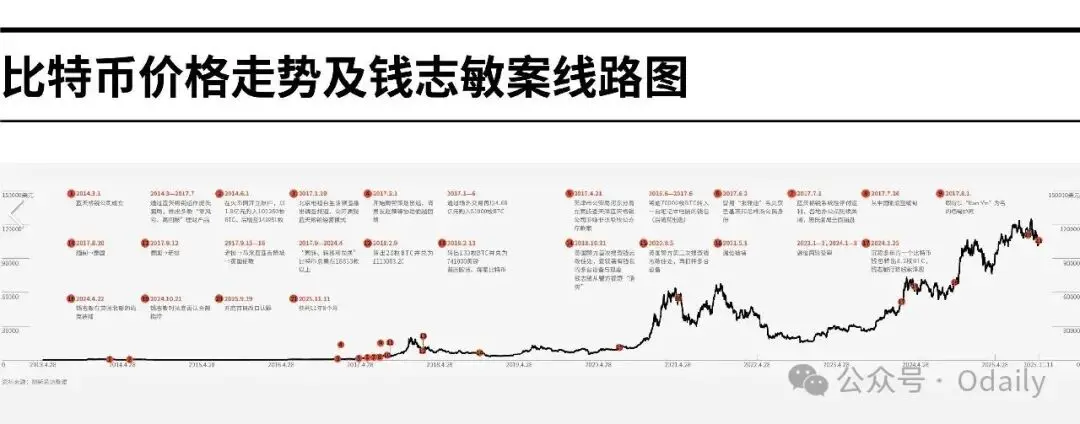
Qian Zhimin Case Timeline Illustration
From the second half of 2016 to 2017, Qian Zhimin stored over 70,000 bitcoins in a wallet on a laptop (Odaily note: information on another 120,000+ BTC has not yet been disclosed. According to a diary seized by UK police, Qian Zhimin once wrote that she “lost 20,008 BTC”), and combined with information that she “circulated, transferred, and exchanged” more than 18,833 bitcoins during her time in the UK, the final number of BTC seized by UK police was about 61,000, plus BTC and XRP tokens worth £67 million.
The key to Qian Zhimin’s eventual arrest was that UK police monitored suspicious wallet addresses through a money laundering investigation and, combined with Binance KYC information, exposed the on-chain and off-chain behavioral tracks of her subordinate “Seng Hok Ling” (transliteration: Lin Chengfu) and others. In April 2024, Qian Zhimin was arrested in her sleep at an Airbnb apartment in Yorkshire, UK.
This once again shows that assets can exist on the blockchain in the digital world, but humans ultimately cannot survive without their physical bodies in the real world, and the off-chain space is under the jurisdiction of authoritarian governments.

Imagination VS Reality
These two cases, involving more than 180,000 BTC in total, have also led the market to re-examine the real boundaries of Bitcoin’s “censorship resistance” and “anonymity” narratives. Of course, in reality,with the launch of BTC ETFs, deep participation of institutional funds, and further regulatory requirements for crypto asset transparency, Bitcoin’s early narrative centered on anonymity and censorship resistance has long faded from the mainstream stage.
Meanwhile, ZEC, which flies the flag of “POW privacy token,” has become the “new promised land” in the eyes of many Bitcoin OGs, Bitcoin fundamentalists, and tech geeks.
Privacy BTC is dead, privacy coin ZEC rises: The market re-prices “new safe haven assets”
If ZEC’s “second spring” in the early stage of rising from $60 to over $100 still relied on the open support of crypto big names such as Naval, 0xmert, Arthur Hayes, and Ansem, after breaking through $200, $400, and $700, the market buying power has long shifted from short-term speculative hot money to real privacy-demanding holders such as Bitcoin OG whales and Bitcoin fundamentalists.

ZEC Price Trend in the Past Month
Specifically, ZEC, with its main concept as a “privacy token,” has the following advantages:
First, it has ample liquidity based on mainstream CEXs.According to Coingecko, as of writing, ZEC’s 24-hour trading volume exceeded $2.26 billion, with Binance and Coinbase ranking first and second in 24-hour trading volume, accounting for over 33% and nearly 11% respectively. In today’s market with tight liquidity, such a unique “CEX ecological niche” provides ZEC with a large enough stage to attract funds and achieve a counter-trend rise.
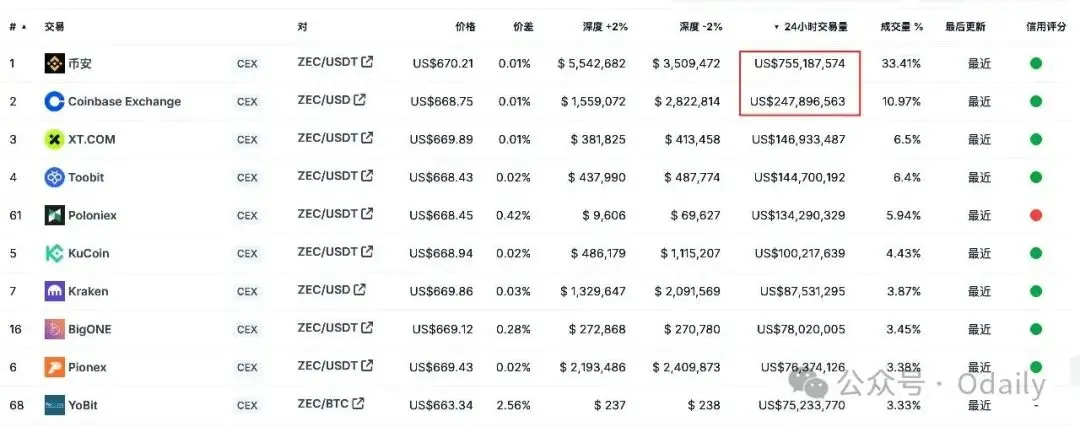
Second, there is real market demand for its differentiated “anonymous privacy pool” (Shielded pool).Data shows that Zcash (ZEC)’s shielded supply once approached 5 million coins on November 3; as of writing, it remains above 4.82 million, accounting for about 30% of the total circulating supply; on-chain, there are over 26,000 transactions in 24 hours; more than 2,200 shielded transactions in 24 hours. This shows that ZEC’s real adoption data is extremely stable and active.
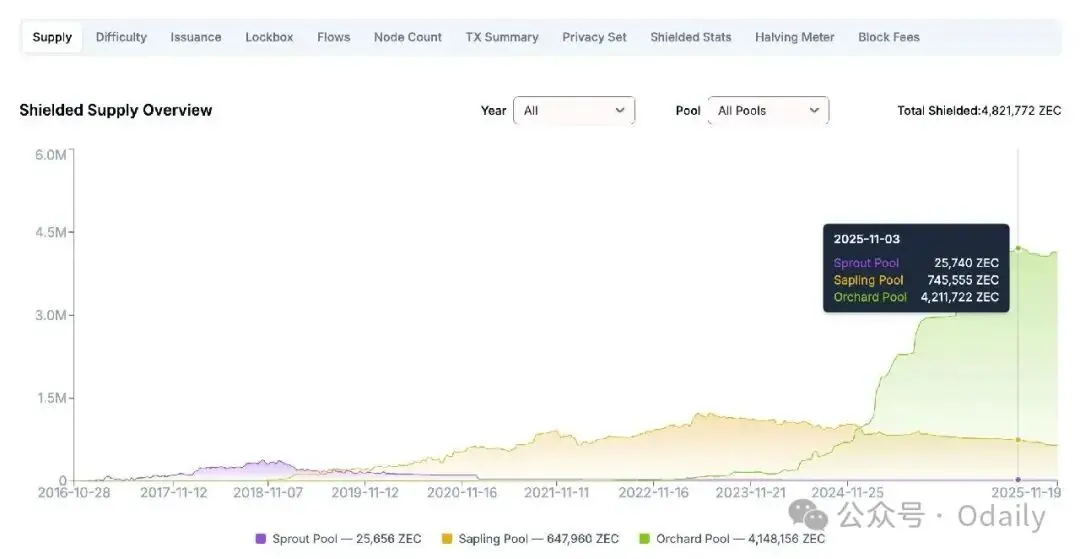
Third, it has a relatively stable token circulation and a smaller market cap compared to other mainstream tokens.According to Coingecko, ZEC’s total circulating supply is nearly 16.4 million, with a total market cap of about $11 billion, ranking 16th among cryptocurrencies by market cap; excluding USDT, USDC, stETH, wstETH, WBTC and other stablecoins and wrapped tokens, it ranks 11th, and compared to other mainstream coins with market caps of tens or even hundreds of billions of dollars, it has more room to rise.
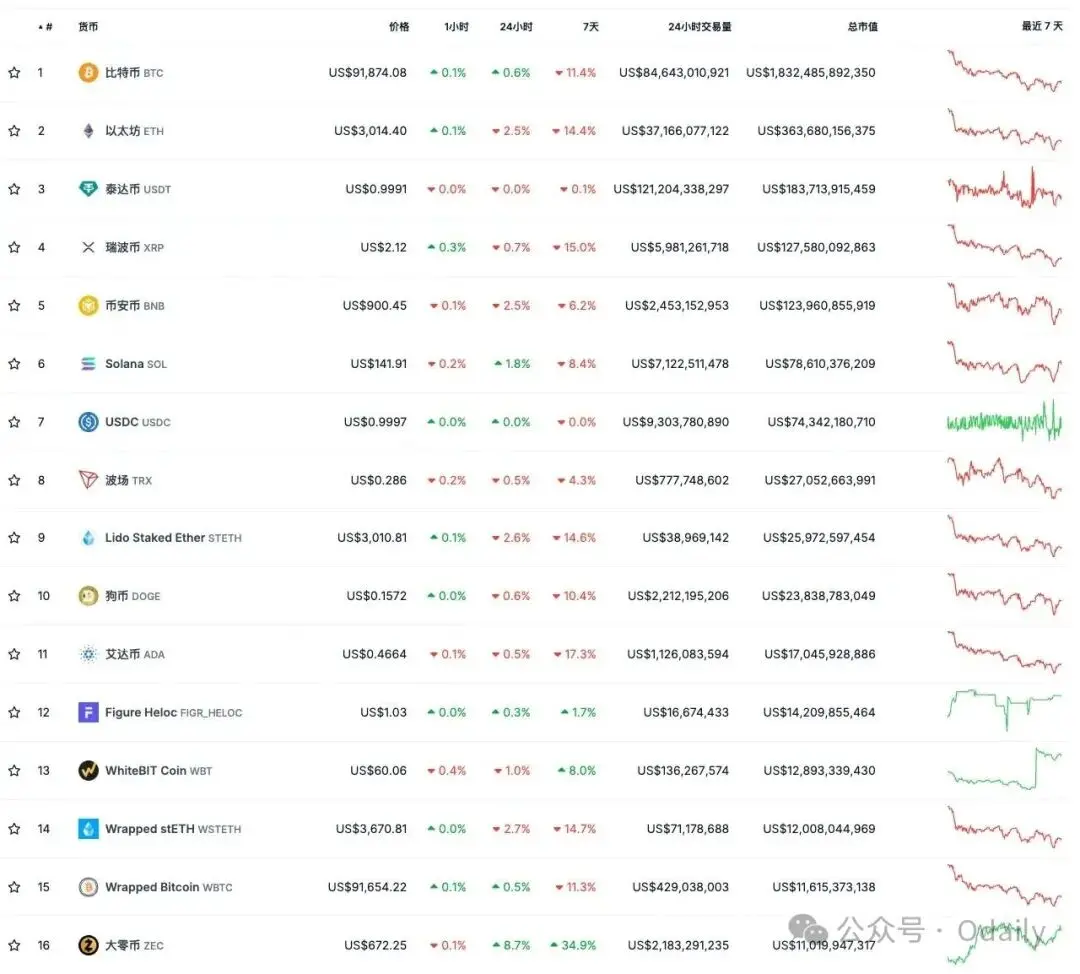
Fourth, it has more complete compliance and faces less regulatory pressure.Unlike controversial privacy tokens like XMR and DASH, which have been embroiled in lawsuits, as a mainstream privacy POW token, the ZEC ecosystem has no direct conflict with regulators, and its POW mechanism ensures stronger censorship resistance to some extent. According to the Q4 2025 roadmap released by ZEC development organization Electric Coin Co. (ECC), ZEC has certain technical advantages. In addition, compared to XMR, ZEC’s optional privacy mode provides institutions with room for compliance and reporting, making ZEC an asset acceptable to regulators.
Fifth, ZEC’s long-standing ecosystem and its geeky, tech-oriented community are also advantages.As the birthplace of ZK-Rollup technology, the ZEC community includes many tech leaders, crypto OGs, and well-known angel investors, including still highly active crypto KOL Cobie (who claims to have held ZEC since 2016), Gemini co-founder Tyler Winklevoss (who wrote in 2021 that ZEC is “the most undervalued cryptocurrency”), and others.
Based on these five major advantages, ZEC naturally becomes the first choice for many BTC whale holders, fundamentalists, and censorship-resistant asset advocates for “sensitive asset migration.” This is also supported by multiple data points.
Analyzing ZEC Market Performance from a Trading Perspective: From Real Adoption to Mainstream Market Focus
In the previous article “Buying ZEC to Dump BTC? Four Industry Truths Behind the Privacy Coin Surge”(https://www.odaily.news/zh-CN/post/5207240), we analyzed in detail the possible reasons for the privacy token sector’s recovery, and the data performance of ZEC during this month’s rise once again proves that its maindriving force is the combined effect of market sentiment and real adoption, rather than market manipulation by whales.
ZEC Becomes a Major Contract Holding Target: 24-Hour Trading Volume Second Only to BTC, ETH
According to Coinglass, in the past 24 hours, ZEC’s total liquidation amount exceeded $72.88 million, with short liquidations exceeding $69.3 million, making it the third highest in 24-hour liquidations after ETH and BTC.
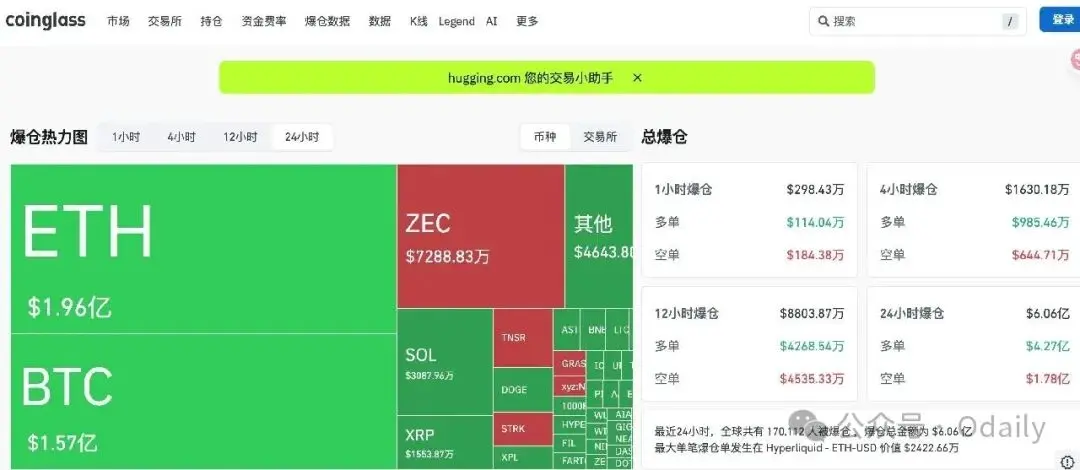
ZEC Ranks Third in “Contract Liquidation List”
In addition, ZEC’s contract trading volume and open interest have remained high: as of writing, 24-hour trading volume exceeded $6.6 billion; 24-hour open interest exceeded $1.2 billion.
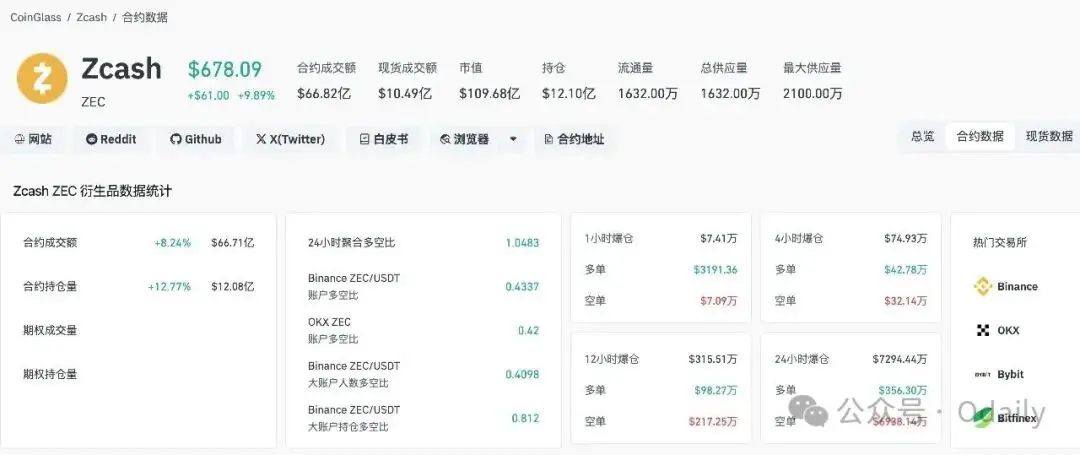
ZEC Contract Data Far Ahead
On the spot side, ZEC trading on major CEXs has also consistently remained in a net inflow state: from October 1 to now, in 50 days, ZEC spot had net outflows on only 15 days; in 30 days, ZEC spot net inflow was about $316 million; in 50 days, ZEC spot net inflow was about $419 million. In 24 hours, ZEC spot trading volume on Binance exceeded $720 million, with a 24-hour increase of over 21%; on Coinbase, spot trading volume exceeded $230 million, with a 24-hour increase of over 17%.

ZEC Spot Inflow and Outflow Data Chart

ZEC Spot Trading Heatmap and 30-Day Trading Data
Behind ZEC Price Changes: From BTC Trading Volume to Market-Wide Pursuit
Aside from the overall trading volume, from the perspective of BTC trading pair volume, we can see two major stages ZEC has gone through:
First, before November 7,BTC trading volume showed a gradual upward trend overall. On the day ZEC price broke through the yearly high of 700, BTC trading pair volume once exceeded 110 coins. At this time, a considerable portion of ZEC’s overall buying was still done with BTC;
Second, after November 7, ZEC became one of the few hot assets in a declining market. Coupled with the previous “Chen Zhi case,” “Qian Zhimin case,” and BTC ETF net outflows, market attention gradually shifted to a stage of widespread pursuit.
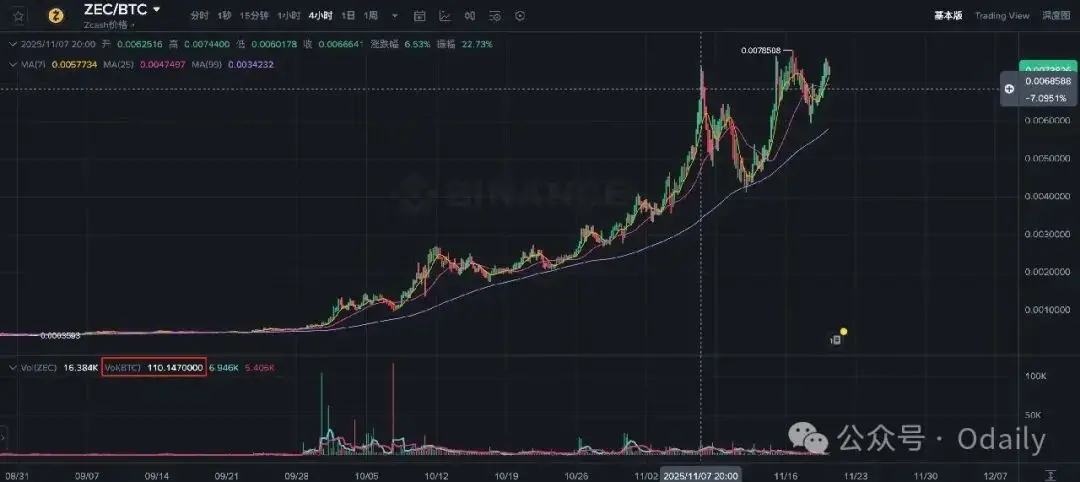
ZEC/BTC Trading Pair K-Line Trend
Looking back at the stage after ZEC’s slow rise in October, entering November, ZEC’s upward curve is undoubtedly steeper, which is influenced by the overall market trend and also highlights ZEC’s real use cases and large capital capacity.
Especially after the first week of November, following a series of news events, BTC’s privacy and censorship resistance attributes were further questioned by the market; conversely, ZEC’s “privacy coin attribute” was once again highly recognized by the crypto market.
In the second week of November, discussions about “BTC no longer private” were rampant on X. On November 14, Simon, a member of the Delphi Digital team, published a long article summarizing and concluding that “ZEC takes over from BTC as a value storage carrier with privacy and self-sovereignty.”
Thus, after more than a month of development, amid the industry’s downward trend, ZEC has officially become the mainstream narrative of the industry. Many traders who previously sold all their ZEC at $300 or $400 have bought back in large quantities, resulting in the first wave of “collective consensus buying.” The main features of the market at this time are:
- ZEC’s daily gains repeatedly stayed at 20–30%, ranking among the top gainers on CEXs;
- Many crypto OGs explicitly stated “BTC privacy is dead, ZEC is the true privacy token,” including BitMEX co-founder Arthur Hayes, who stated on November 7 that ZEC has become the second largest liquid holding in his family office fund Maelstrom Fund, second only to BTC; on November 16, he even launched a “meme creation community event” to further highlight ZEC’s ecosystem activity, saying “the most wanted Christmas gift is ZEC.”
- Privacy sector tokens such as XMR and DASH also rose slightly in tandem;
- Natural buy orders appeared in the order books of Binance, Coinbase, and OKX.
Even Google Trends searches for “Zcash” and “ZEC” once surged by 200%–300%; more importantly, ZEC’s real market demand, emotional hot spot, and active trading have also attracted high attention from the capital markets. As mentioned earlier, Gemini co-founder Tyler Winklevoss has put real money into buying ZEC.
ZEC Treasury Company Established: Aiming to Buy at Least 5% of Tokens
On November 12, Nasdaq-listed Leap Therapeutics announced the purchase of 203,775.27 ZEC tokens at an average price of $245 per token and announced its transformation into a ZEC treasury company, renamed Cypherpunk Technologies Inc. In addition, the company announced it had secured $58.88 million in private financing led by Winklevoss Capital.
On November 18, Cypherpunk Technologies Inc. (Nasdaq: CYPH) announced it had spent another $18 million to purchase 29,869.29 ZEC (Zcash) at an average price of $602.63. Together with the previous $50 million purchase, Cypherpunk’s total ZEC holdings have reached 233,644.56, with an average holding cost of $291.04.
This acquisition brings the company’s total ownership in the Zcash network to 1.43%.Cypherpunk focuses on privacy and self-sovereignty, considering Zcash as “an asset form of digital privacy” and a hedge against Bitcoin’s transparency and its financial infrastructure, especially in an AI-rich future. Previously, the company appointed Will McEvoy, head of Winklevoss Capital, as Chief Investment Officer (CIO) and board member; Winklevoss Capital led the $58.88 million private placement. The company’s goal is to ultimately hold at least 5% of ZEC’s total supply, continuing to advance its Zcash-centric digital asset treasury strategy.
Whether ZEC can become the next crypto asset after BTC to be heavily bought by Wall Street capital institutions and crypto capital remains to be seen as ZEC’s value continues to be discovered and may attract widespread attention.
Conclusion: Is ZEC “BTC Privacy Insurance”? Perhaps Much More Than That
Of course, we are not encouraging investors to chase ZEC at high prices. What we present is an objective analysis based on public data, market structure, and demand—from a longer-term perspective, ZEC’s long-term trend may still have room to continue.
In the article “Why Did Naval Say: Zcash Is Insurance for Bitcoin Privacy?”(https://www.odaily.news/zh-CN/post/5207299), Max Wong from IOSG Ventures explained in detail the reasons for ZEC’s rise and the technical principles behind it, and the core view is exactly what Silicon Valley investor Naval said when he first “endorsed” ZEC:“Bitcoin is insurance against fiat; Zcash (ZEC) is insurance against Bitcoin.”
Now, in addition to being exchangeable with BTC and filling its privacy gap, ZEC is gradually taking on the new narrative expectation of “taking over as the censorship-resistant asset from Bitcoin” in the eyes of some market participants.
As we approach the quarter-century mark of the 21st century, the value of freedom may no longer be defined solely by BTC, which is driven by compliance and deep institutional participation, but more likely by those technical solutions that still focus on privacy and sovereignty.From this perspective, the return of ZEC is like a “sovereignty signal” that reignites market discussion.
Disclaimer: The content of this article solely reflects the author's opinion and does not represent the platform in any capacity. This article is not intended to serve as a reference for making investment decisions.
You may also like
Why the plunge was even more severe than the market expected
System uncertainty and pressure are increasing.

How does the leading player in perpetual DEX view the future trend of HYPE?
If you believe that the trading volume of perpetual DEXs will continue to grow, then HYPE is one of the purest and most leveraged ways to capture this trend.

ETH Plummets and Rebounds: A Market Baptism Amidst the Storm
Bitcoin market reshuffle: who is selling?

